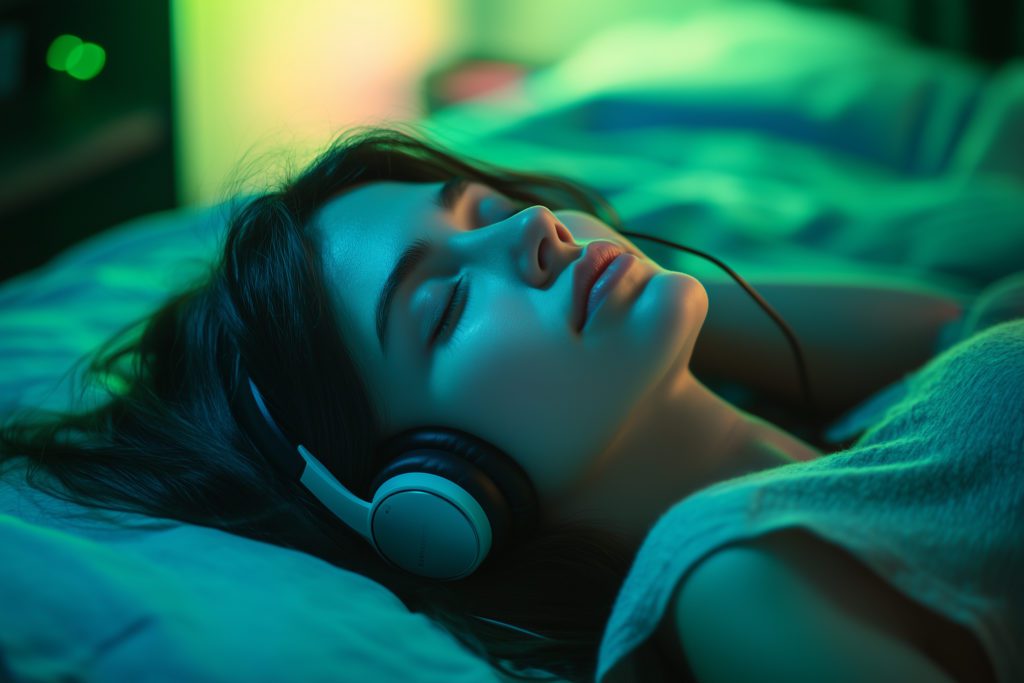
The Science Behind Color Noise: How Different Frequencies Affect Brain Waves and Sleep Patterns
Colored noises can improve your sleep, with some directly affecting your brain waves. Explore the science behind color noise and how to sleep better.

The term “colored noise” comes from colors being labeled for a specific frequency range, often based on their relationship to other colors. While white noise is the most commonly referenced colored noise, others exist, and some may prove more pleasant-sounding than the stereotypical white noise.
Colored noises do more than provide background noise, though; colored noises and their unique frequencies can produce changes in the brain and prompt different effects on your mood. If the right colored noises are chosen, you may even be able to improve your sleep.
What Are Colored Noises?
Colored noise is a term used in audio engineering to describe different types of noises. Colors fall within the visible light spectrum, with each color having its own frequency of light. In this same way, colored noises have a specific frequency that they cover, and they’re typically related based on their relationship to other colors.
For example, white light is an accompaniment of all visible light and all colors, and in this same way, white noise has an equal power over all audible frequencies. Some examples of white noise include fans, TV static, and a vacuum cleaner.
In comparison, pink noise, while it contains all the frequencies, just like white noise, places a higher emphasis on the lower frequencies compared to the higher frequencies. The result of this is a softer, more balanced sound that often resembles the sounds you would hear in nature, such as rain, wind, a waterfall, or ocean waves.
Other types of colored noises include:
- Brown noise: This noise also includes all the frequencies, but it is softer than white noise. It’s often compared to rumbling thunder.
- Green noise: This noise focuses more on sounds in the middle of the spectrum, like the human voice, and may sound similar to a babbling brook.
- Blue or purple noise. The frequency of these noises is higher than white noise, creating a sound that is similar to a hissing garden hose. It can be quite annoying, and they are not typically listened to on their own. Instead, blue or purple noise is used by audio engineers for a process called dithering, in which they use low-level noise to smooth out audio recordings.
These different frequencies can produce different effects on your mind, which can then affect your sleep patterns.
How Colored Noises Affect Your Mind (and Sleep)
While noise is often considered to be distracting, there are certain circumstances where environmental noise, and especially colored noises, can be beneficial.
Still, certain noises are more conducive to sleep than others.
Pink noise, in particular, has been shown to synchronize brain waves and induce brain activity into a specialized state that is a lower complexity level, which improves sleep stability. This ability of pink noise to enhance the quality of sleep has been shown in various studies, including one on elderly individuals, which also showed that pink noise can improve depression in older individuals.
White noise, as well, may offer sleep benefits. One study on colicky babies found that playing white noise significantly decreased how long they spent crying and increased their sleeping durations compared to placing the babies in a swing. It’s even suspected that white noise can help relieve pain in babies with colic who are crying. It has also been used in treating insomnia and tinnitus while also being capable of masking unwanted sounds, all features that equate to a better night of sleep.
If you live in an urban environment where all kinds of noises keep you awake at night, white noise may help you sleep better. Studies have also shown that listening to white noise reduces the amount of time it takes to fall asleep by 38%. If you’re struggling to fall asleep, white noise may help.
While pink and white noise are most common in the scientific literature regarding their benefits for sleep, other colored noises may be able to help you prepare your mind for sleep. For instance, research has also shown that brown noise can help enhance the transition into REM sleep for some individuals.
Green noise, as well, may create a soothing quality. This noise centers around a frequency of 500 Hz, which is similar to sounds that fetuses start responding to while in the womb around 19 weeks of age. In this way, the 500 Hz frequency range may offer some biological soothing quality.
All of these colored noises offer a benefit for your sleep, but it’s important to be aware that some may also provide daytime benefits, such as the improved focus offered by brown noise. In this way, brown noise may be a better colored noise for use in the daytime compared to at night. Some experimentation is required to determine which colored noises help you sleep.
Using Colored Noise to Sleep Better
Research shows that colored noises help people fall asleep more easily and sleep more soundly through the night, so they can be a helpful addition to your nighttime routine. Whether you want to relax from your day or block out distracting noises, there’s a colored noise available to help.
Some tips for using colored noises to sleep better include:
- Experiment. There are many different colored noises, and even within each category, there may be variations in type. Experiment until you can find one that is most soothing for you and accomplishes the task you’re looking for. For instance, if you need something to block out noises, white noise is often best, but if you’re looking for something that is soothing and can improve sleep quality, pink noise may be a better option. Even if one noise is said to offer the benefits you’re seeking, you may not mesh well with it; continue experimenting until you find one that produces the desired results.
- Make it a routine. If you’re looking to add colored noises to your sleep routine, be sure to be consistent with it. Whether you put them on while you get ready for bed or turn them on before getting into bed in order to block out noise, be consistent with them to see the greatest results.
- Keep it low. Louder does not equate to better results. In fact, listening to colored noises at too high of a volume could damage your hearing or may result in a headache. Instead, keep them at the lowest possible volume that still produces the desired effect.
Ultimately, if you’re looking to fall asleep easier and sleep more soundly during the night, it may be time to add some colored noises to your night. Experiment during the day to find one that promotes relaxation and allows you to drift off to sleep.

Written by
Jessica G
Medical writer freelancer who has written hundreds of articles on varying topics. Masters of Engineering degree in Biomedical Engineering.
Download Pillow
Get help
Press & News
Legal
Connect
X (Twitter)
Company
Copyright © Neybox Digital Ltd.



